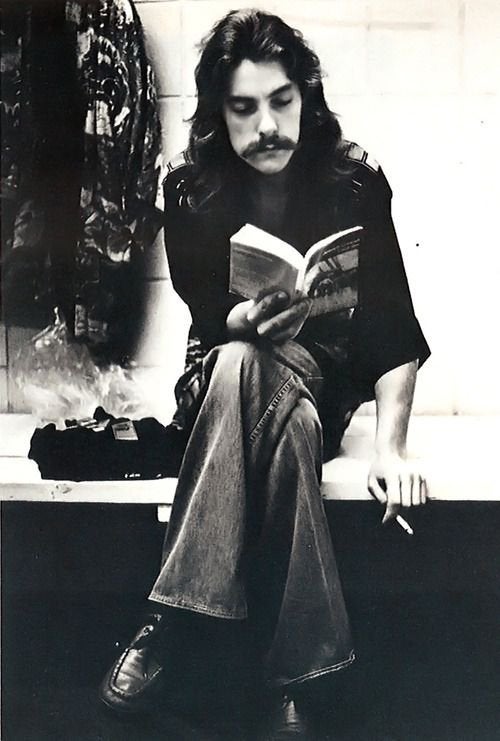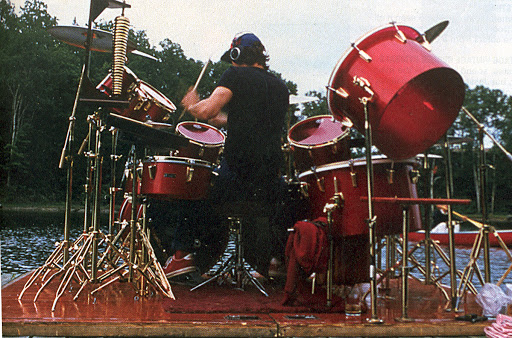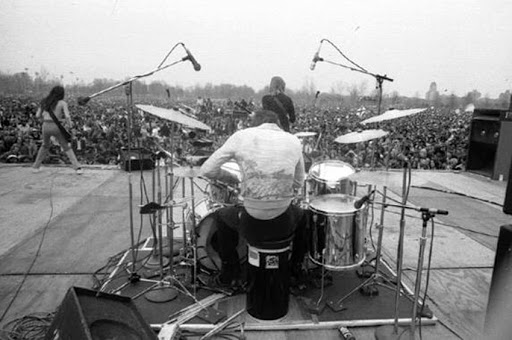Poet To Pen: A Tribute to Neil Peart’s Lyrical Prowess
By Steven Shinder

Photo: Fin Costello/Redferns, taken in Cleveland on Dec. 17, 1977
Only one week after Don George’s passing, Neil Peart’s first drum teacher, Neil passed. The news did not come out for three days, as Neil was a very private man, even in his passing. Like many, Neil Peart and Rush were a big part of my musical life and influences. I believe I saw Rush more than any other band. YES may be the only exception. I believe I saw Rush perform 14 times, going back to twice on the 1978 Hemispheres tour.
I have always been a fan of Neil’s lyrics as well. I will turn this section over to my son Steven, who wrote this tribute to Neil’s lyric-writing prowess.
-Dan Shinder, Founder of Drum Talk TV

Photo: Andrew MacNaughton
Coincidentally, on January 7, without knowing that Neil Peart passed away that day (as news came out 3 days later), my dad gave me the task to write an article about Neil’s lyric-writing prowess. So what I would like to touch upon is how most of the lyrical content that he wrote differed greatly from most rock bands. He wrote about cars, history, nature, mythology and more. Of course, he also wrote about life lessons and relationships every now and then, but these were not always love stories. He was very well-read, his words carrying the influence of literary works by the likes of Edward Abbey, Samuel Taylor Coleridge, Richard Foster, John Dos Passos, J.R.R. Tolkien, Mark Twain, Walt Whitman, and Thomas Wolfe. Peart even wrote books of his own, memoirs to share with the world.

Neil reading in the dressing room, 1976 – Photo by Fin Costel
It can be difficult to narrow a piece like this down to a few selections. Neil Peart wrote the lyrics to the majority of Rush’s catalog, and one could spend time combing through everything and talking hours at length since it is all worth discussing. For this piece, however, we will go through one, two, or three selections from each album that, together, do a fair job of illustrating just the type of writer Peart was. What’s great is that the conversation can still continue beyond this, between fans all around the world. This is subjective to one’s own sensibilities, and this is in no way a “Best Of” list or prioritizing any of his work ahead of his others.
When Peart joined Rush for their second album, Fly by Night (1975), he wrote the lyrics to six of the eight tracks. One of those tracks was “By-Tor & the Snow Dog.” Divided into eight sections, the only ones with lyrics are “At the Tobes of Hades,” “Across the Styx,” and “Epilogue.” At first glance, it seems that Peart was very interested in referencing Greek mythology. However, the song itself was inspired by two real-life dogs named Biter and Snow Dog, whose owners were Rush’s manager and their lighting man, Howard “Herns” Ungerleider. So with this song, Peart had a fun melding of humor and mythology. The lyrical con-tent sounds like there is such an epic battle and perhaps a serious tone in the words “Disciples of the snow dog sound the knell.” But when one takes into ac-count the actual inspiration for the song, there is also an undertone conveying that fantasy and mythology don’t always need to be too serious.

Rush, Fly By Night Tour 1975 – Photo by Bill Greenbladt
According to a 1975 interview with St. Catherine’s Standard, the “mythological sequel” to “By-Tor & the Snow Dog” was “The Necromancer” from their next album Caress of Steel (1975). One might think that the latter song was more connected to “Rivendell” from the previous album since they both seem to be Tolkien-influenced, but apparently, Peart saw “By-Tor” and “Necromancer” as the tracks that were more connected. The latter is also divided into sections, and it has such words as “men of Willowdale” that really capture the feel of a fantasy story. The longest song on Caress of Steel is actually the side-long “The Fountain of Lamneth,” which contains references to Panacea – a Greek goddess of universal remedy – and Bacchus – a Roman god of agriculture.
Despite all this, “2112” (from their 1976 album of the same name) is widely considered Rush’s breakout epic, and is perhaps seen by many as the best starting point for anyone who wants to start getting into their music. One memorable verse from this epic is, “We are the Priests of the Temple of Syrinx.” It sounds so strange, but it somehow became such a catchy Rush verse to sing.

1976 2112 Tour (before they themed Neil’s drums and the stage for each cur-rent album’s tour artwork) Photo by Fin Costello
Peart incorporated words that sound obscure or of a higher vocabulary, and they worked. These words in particular also add to the world-building of the song, along with the Peart-spoken, “Attention all Planets of the Solar Federation.” He knew how to make the story of this song feel like a lived-in world.
This world-building trend would continue with Peart’s contributions to the next album, A Farewell to Kings (1977). “Xanadu” references Samuel Taylor Coleridge’s poem Kubla Khan by describing the river Alph and how the titular place may be able to grant immortality. Again, these themes sound like the lore of mythology. Meanwhile, “Cygnus X-1 Book I: The Voyage” tells the story of a journey toward a black hole. At the end, we get an effective feel of what it is like to go through such a perilous journey: “Sound and fury drown my heart/Every nerve is torn apart.”

1977 A Farewell to Kings Tour – Photo by Fin Costello
Of course, this was only part of a complete story. On the next album, Hemispheres (1978), Rush fans got the rest of the story in the form of “Cygnus X-1 Book II: Hemispheres.”

1978 Hemispheres Tour – Photog unknown
Here, Peart took the protagonist to Olympus, where he sees Greek gods Apollo and Dionysus at odds with each other. Peart wrote out the twist very effectively:
They sat a while in silence
Then they turned at last to me
“We will call you Cygnus
The god of Balance you shall be”
Going into Permanent Waves (1980), Rush were entering a new era, with songs that felt more streamlined for radio airplay. This is apparent right from the opening track “The Spirit of Radio,” which seems to alleviate worries about technological advances by saying, “All this machinery/Making modern music/Can still be open-hearted.”

Rush in Le Studio during the Permanent Waves Sessions
Rush were adapting but still trying to be true to themselves. More commentary on technology appears in “Natural Science,” a reminder to take care of the Earth.
As Rush continued to embrace new technology, Peart kept the lyrical content intelligent. On Moving Pictures (1981), “Tom Sawyer,” one of their most popular songs begins with catchy rhymes:
Modern-day warrior
Mean, mean stride
Today’s Tom Sawyer
Mean, mean pride
Despite the catchiness, the lyrics still felt literary through the use of verses such as, “His reserve was a quiet defense,” and, “Always hopeful, yet discontent.”

Neil out for a sail, 1981
Keeping with the literary theme, “Red Barchetta” was inspired by a Richard Foster short story titled “A Nice Morning Drive.” Both stories talk about a future in which vehicles are regulated. And “The Camera Eye” contains references to the U.S.A. novel trilogy by John Dos Passos, where the stream of consciousness sections are known as “The Camera Eye.”
On Signals (1982), Peart was bold enough to use “Subdivisions” to illustrate the vibe of isolation and cliquishness in high school. He shed light on a world where people were expected to think a certain way in order to be “in,” hence the verse, “Conform or be cast out.” And of course, there is also “the restless dream of youth,” a longing for something better to come along whilst stuck in a lonely environment. Sometimes, it is a feeling that is difficult to escape.

Neil Peart 1982 Signals Tour – photog unknown
On Grace Under Pressure (1984), Peart used “Afterimage” to deal with the loss of friend Robbie Whelan, who had worked as an assistant engineer for Rush. Peart set the tone with “Suddenly you were gone/From all the lives you left your mark upon,” demonstrating the weight that the loss of a person has and reminiscing about drinking, running, and skiing. It just goes to show that memories of a person can rush back through the mind once they are gone. The aftermath can be very painful.

1984 Grace Under Pressure Tour
Peart also showed the reach of his memory by consistently adding different parts of a story called “Fear” on these last three mentioned albums. Released in reverse order, Parts I, II, and III of “Fear” were titled “The Enemy Within,” “The Weapon,” and “Witch Hunt,” respectively. To have songs of one story each on one album, whether they be released back to back or after a large gap of time, is not something you often hear about. It’s almost unheard of. And the songs sound so different in style that one might not put together right away that they are of the same story, despite the common theme of fear that runs through them. Eventually, Part IV would be released on Vapor Trails (2002) in the form of “Freeze.”
In the meantime, Peart kept on bringing Rush through the 1980s. On Power Windows (1985), “Manhattan Project” talked about the creation of nuclear weapons, which could have a great impact on the world. And on “Middletown Dreams,” he captured that feeling of yearning for something better. This song, by the way, happens to be one of my dad’s favorites to play. And you can catch him doing so from time to time on “Dan Shinder’s Almost Daily Vlog,” live on the Drum Talk TV Facebook page and then archived there as well.

1985 Power Windows Tour – Photog unknown
Each day is a struggle, as told in the verses, “Another day as drab as today/Is more than a man can endure.” Peart continues by delving into this state of mind:
Dreams flow across the heartland
Feeding on the fires
Dreams transport desires
Drive you when you’re down
Dreams transport the ones
Who need to get out of town
One gets a sense of time passing by while very little changes for the better. By contrast, Peart’s lyrics to “Time Stand Still” from Hold Your Fire (1987) actually convey time passing by with so much changing that it all feels so overwhelming as “The innocence slips away.”

1987 Hold Your Fire Tour – Photo Andrew MacNaughton
And while Rush is widely known to be a rocking band, their music also had selections that were soft yet reflective. “Second Nature” from Hold Your Fire is an example of that. It is a song about how, while people are different, they still all need to work toward making things better.
On Presto (1989), “The Pass” brought attention to how young people sometimes contemplate suicide. This can sometimes feel like a taboo subject, but over the years, people have come around and talked more openly about mental health. Suicidal thoughts happen, and Peart captured the emotion of the thoughts of hopelessness:
And now you’re trembling on a rocky ledge
Staring down into a heartless sea
Can’t face life on a razor’s edge
Nothing’s what you thought it would be

1989 Presto Tour – Photog unknown
“Ghost of a Chance” from Roll the Bones (1991) speaks of different pathways, separation between familiar people, what might have been had things gone differently, and finding one another despite all the obstacles. While there are various things that the speaker does not believe in, one thing is clear and optimistic: “But I believe there’s a ghost of a chance/We can find someone to love/And make it last.”

1991 Roll the Bones Tour – Photo by Andrew MacNaughtan
On Counterparts (1993), Peart returned to the theme of diverging paths via “Nobody’s Hero.” Peart continued to be open by writing about Ellis, a homosexual with whom he had spent time as a friend before they drifted apart. And the news of Ellis’ death from AIDs was devastating when Peart heard about it. The details of the song may have been taboo for music of this time. And yet here Peart was, amplifying the sense of loss with such words as, “When I heard that you were gone/I felt a shadow across my heart.”

Counterparts Tour 1993 – Photog unknown
On “Virtuality” from Test for Echo (1996), Peart made a subject as mundane as messaging on the internet sound like an adventure: “I’m a castaway, stranded in a desolate land/I can see the footprints in the virtual sand.” This was an effective way of commenting on how the internet changed the nature of relationships between people around the world.

1996 Test For Echo Tour – Photog unknown
After enduring the tragic deaths of his daughter Selena and his wife Jacqueline, Peart took a hiatus from Rush. His travels on a motorcycle were later detailed in his memoir Ghost Rider: Travels on the Healing Road, which concludes with his marriage to Carrie (with whom he would later have a daughter named Olivia). This book was released in 2002, a couple of months after the song “Ghost Rider” appeared on the revived Rush’s album Vapor Trails. One can imagine the scenery and heaviness of his personal journey:
Carry all those phantoms
Through bitter wind and stormy skies
From the desert to the mountain
From the lowest low to the highest high
Like a ghost rider

2002 from the “Rush In Rio” DVD
Peart’s experimentation with lyrical formats also shows on “The Larger Bowl” from Snakes & Arrows (2007). It incorporates a technique known as the Malaysian pantun, which entails that the second and fourth lines of one stanza become the first and third lines of the next stanza. This song is also effective in questioning why each person’s path is different when people are told that they are one: “If we’re so much the same like I always hear/Why such different fortunes and fates?”

2007 Snakes and Arrows Tour – Photo by Andrew MacNaughton
For the concept album Clockwork Angels (2012), a world with its own story was created, to the point where it was given a novel of the same name (and a sequel titled Clockwork Lives) written by sci-fi author Kevin J. Anderson. (He and Peart had co-written the 1985 short story “Drumbeats.”) The story takes place in a steampunk world filled with the ideas of two extreme opposite figures, The Anarchist and The Watchmaker. A young protagonist goes on a journey where he learns about how the world works and how some things are too good to be true. The final track, “The Garden,” conveys what is most important when living your life:
The treasure of a life is a measure of love and respect
The way you live, the gifts that you give
In the fullness of time
It’s the only return that you expect

2012 Clockwork Angels Tour
In his life, Neil Peart gave us many gifts. Though his life was cut short by disease, he lived his life to the fullest, using his craft to create memorable and thought-provoking music and words. He was a working man, and his lyrical legacy persists through the Rush catalog that is available for all of us to revisit.
“Suddenly you were gone/From all the lives you left your mark upon…”
Rest easy, good sir, from me and the Drum Talk TV family.
Steven Shinder

Rush April 13, 1975, by Bill Greenbladt
